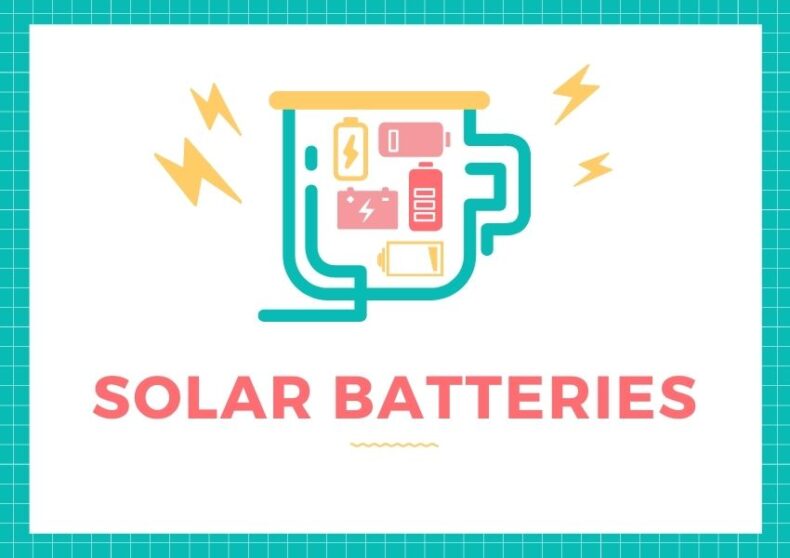Store your solar energy in solar batteries!
Humanity’s continued technological developments are creating an increasing reliance on electricity. Without electricity, cities would be in darkness, businesses would collapse, and households would be in disarray.
Sadly, the vast majority of electricity is still generated using non-renewable forms of energy — fossil fuels.
But there is hope — eco-friendly, renewable energy sources such as solar and wind continue to make ground! The former, in particular, has made massive strides in recent years.
One reason for this is the emergence and continued development of solar batteries.
This article provides an in-depth look at the types of solar batteries out there!
Table of Contents
What Is A Solar Battery?
A solar battery is designed to store electricity produced by solar panels.
The battery is an essential component of your solar system, let’s see why.
Basic Working Principle Of A Rechargeable Battery
Every battery is made of 4 primary components:
- Two electrodes: Anode (-) and Cathode (+)
- A porous membrane that separates the electrodes
- An electrolyte
The nature of these components varies depending on the battery technology.
Anodes and cathodes are usually made of metal, connected by a wire, and immersed in the electrolyte.
An electrolyte is a liquid that contains charged particles called ions; the membrane is porous to ions.
Oxidation And Reduction Reactions
Time for a chemistry refresher:
During discharge, an oxidation reaction occurs at the anode that generates electrons. Meanwhile, at the other electrode (cathode), a reduction reaction using the electrons is happening.
A flow of electrons (electricity) is therefore created between the two electrodes — this is the battery’s output.
The solar battery maintains its electrical neutrality at all times thanks to an exchange of ions in the electrolyte.
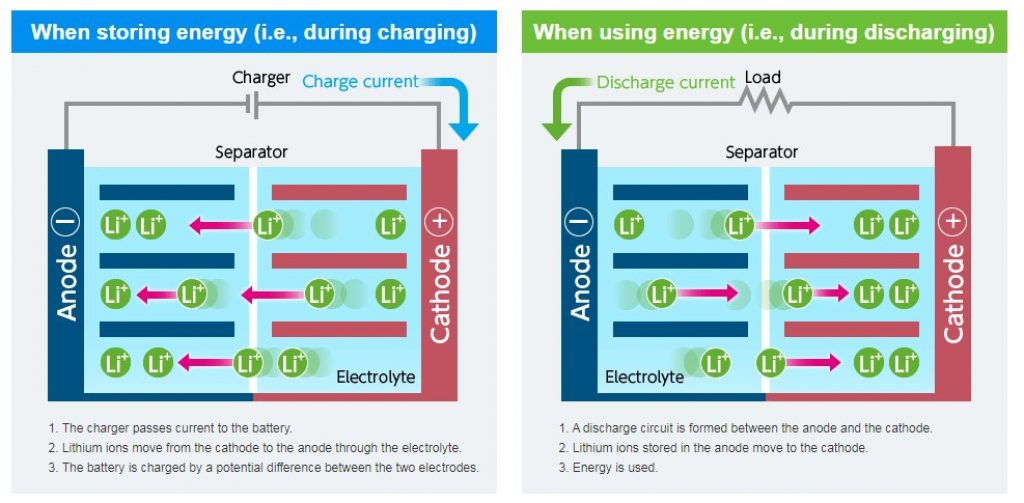
Source: Dimitrios Karamitros
During charging, the opposite reaction occurs — oxidation at the cathode and reduction at the anode simultaneously. The flow of electrons is in the opposite direction compared to discharge mode.
Solar Energy — A Variable Source Of Energy
The photoelectric effect described by A. Einstein in 1905 signifies the birthday of modern solar panels.
A solar panel converts visible light (photons) into electricity (electrons). Thanks to scientists, we now have highly efficient and reliable solar panels.

Source: BBC
Our sun is a natural energy source; therefore, it is intermittent. You will notice its intensity fluctuating throughout the day. Consequently, your solar electricity production will continually change.
You will undoubtedly prefer to use electricity at all times, so you need to store your production. The most versatile and reliable way to store solar energy is through a battery, a solar battery.
Why You Should Couple Batteries To Your Solar Panels
Under real-life conditions, our energy consumption is predictable.
Consumption peaks occur in the morning around 7 am and evening around 7 pm.
Unfortunately, those peak consumptions are far from the peak production of your solar panels — panels produce the most energy when the sun is at its highest (noon). This issue has resulted in the wide usage of batteries.
Batteries and solar panels allow us to use solar energy anytime and under all conditions.
10 Of The Most Useful Battery Terms
If you look at the technical terms of a commercial battery you may find yourself completely lost!
Don’t worry — below you’ll find a list of the 10 most relevant battery terms.
1. Energy
Rechargeable batteries store energy in the form of chemical energy.
Energy is defined as a certain power supplied during a specific time measured in kWh. For example, 1kWh of energy equals 1 kW of power supplied during 1 hour. Therefore, energy = power x time.
On your electricity bill, the energy company charges the kWh consumed monthly—for example, $0.2559 per kWh in California.
2. Power
The battery supplies electrical power measured in Watts (W). Every load connected to your battery will require power to operate at its nominal capacity.
Power = Current (A) x Voltage (V)
3. Voltage
Your battery’s voltage will fluctuate from its nominal value depending on its state of charge, the instant load, and the temperature.
The fluctuation is generally around 20% of the nominal value.
For instance, during charge, a 12 V battery will reach 14.4 V, down to 10 V when fully discharged.
Connecting a heavy load to your battery will result in instant voltage fluctuation.
4. Current
Electric current is measured in Amperes. It is the flow of electrons (electricity) that your battery can release (discharge) or recover (storage).
This value is closely related to the power of your battery.
5. Charging And Discharging
Charging is the storage of electricity in a battery whereas discharging is the supply of electricity by a battery.
6. Capacity
Your battery stores a limited amount of energy (capacity).
This capacity is expressed in kWh, but you can also find it in Ah (Ampere hours) or Amps.
Several factors influence the capacity of your battery:
- Temperature
- State of charge
- Electrical load connected
A high discharge rate will drastically reduce your battery’s capacity.
Example
You might see this type of specification for your battery capacity:
- 12 V nominal voltage
- 100 Ah during 20h at 25°C
The above means that your 12V battery can supply 100 Ah over 20 hours. In terms of energy, it is equivalent to 1.2 kWh over 20 hours:
100Ah x 12V= 1200Wh.
The important figure here is 20 hours — the 1.2 kWh is supplied straight during 20 hours (no peak load, no cut-off). This equates to 60W of load at any time during 20 hours:
60W x 20 hours = 1.2kWh.
In the end, if you exceed this value of 60W over 20 hours, you will discharge your battery quicker and reduce your total capacity.
7. DC (Direct Current)
Batteries use Direct Current (DC) for charging and discharging.
8. AC (Alternating Current)
All your daily appliances use alternative current (AC).
9. DOD (Depth Of Discharge)
To improve battery life duration, manufacturers do not recommend discharging the battery fully.
The advised DOD may vary depending on the type of battery:
- Lead-acid — 50%
- Lithium — 80%
10. Cycle Life
Cycle life is the number of times you can fully discharge and charge your battery until its rated capacity falls below 70%.
What Are The Different Kinds Of Solar Batteries?
The 2 primary battery technologies available are:
- Lead-acid
- Lithium-ion
Both share the same working principle. However, they differ in their active material.
One of the essential features you want to pay attention to is energy density. This is the energy your battery can store per kilo (kWh/kg) — the higher this value, the better.
Both technologies are available in different energy storage capacities. A lead-acid battery’s nominal voltage is typically 12V. Conversely, a lithium-ion battery’s can be 12V, 24V, or 48V.
Let’s take a closer look at the different technologies and see what is best for a solar battery.
Lead Acid Battery
Our oldest rechargeable battery technology was developed more than 150 years ago by French scientist Gaston Planté.
Fun fact: do you know that the first car to reach 100 km/h was an electric car with lead-acid batteries built in 1899?
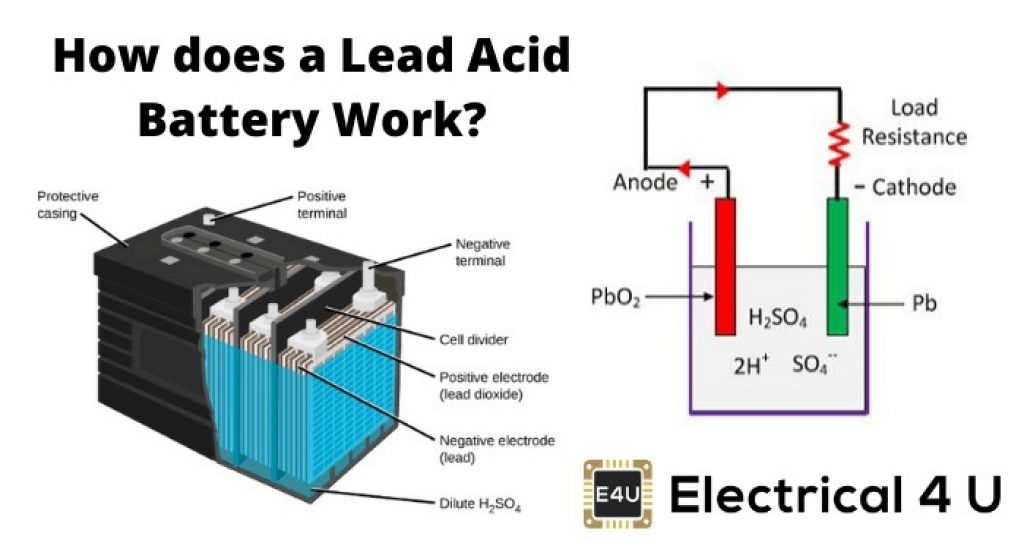
A lead-acid battery’s energy density is low, on average 35 Wh/Kg. This is primarily due to the heavy weight of lead electrodes.
Below is a quick look at a lead-acid battery’s main components:
| Component | Material |
|---|---|
| Anode (-) | Lead (Pb) |
| Cathode (+) | Lead (Pb) |
| Electrolyte | Sulfuric acid (H2SO4) |
| Membrane/Separator | Depends on the technology (fiberglass mat, rubber…) |
Deep Cycle Battery
Lead-acid batteries were primarily used to crank cars. They produce high current pulses and will not undergo deep discharge.
Conversely, a solar battery requests a steady discharge current flow over time with a deeper depth of discharge (DOD).
Deep cycle batteries use thicker lead electrodes and separators to increase the depth of discharge
Deep cycle lead-acid batteries are divided into 2 groups:
- Wet or flooded battery (refillable)
- Valve-regulated lead acid battery (VRLA)
Related Reading: Do Deep Cycle Batteries Need To Be Vented?
Wet/Flooded Lead Acid Battery
Wet batteries have a liquid electrolyte that you need to monitor to ensure that the electrodes are fully immersed.

They must be refilled with distilled water and well-ventilated as they can release hydrogen if overcharged.
Properly maintained wet batteries exhibit a slightly longer useful life than VRLA batteries. However, it is not recommended to purchase this type of battery.
Wet batteries are not user-friendly — they require safety precautions during maintenance and operation and have a longer recharge time.
Currently, VRLA-type batteries are replacing wet batteries.
Valve-Regulated Lead-Acid Battery (VRLA)
VRLA batteries are sealed and maintenance-free batteries. They are available as Gel and AGM batteries, highlighting some technological features.
Let’s take a look at some of their characteristics:
AGM battery
Absorbent Glass Mat (AGM) is a material that composes the battery separator of an AGM battery. This type of lead-acid battery absorbs the electrolyte on a fiberglass mat. Therefore, these batteries are sealed and maintenance free.

Are AGM Batteries Safe?
This type of battery is safe to operate and maintenance-free as they don’t need to be refilled. They are sealed to prevent any emission of gas.
How Long Do AGM Batteries Last?
The total life cycle of AGM batteries strongly depends on the depth of discharge (DOD).
An AGM battery’s life can vary between 200 and 1,000 cycles. Usually, the manufacturer recommends a 50% DOD, allowing a total of 500 to 700 cycles.
Are AGM Batteries A Good Choice As Solar Batteries?
AGM batteries are a good choice as solar batteries for low-budget systems. They can undergo deep discharge and are more durable than car batteries.
Gel Batteries
Gel batteries are lead-acid batteries with a semi-solid (gel) electrolyte. In this battery, silica is added to the sulfuric acid electrolyte to make it a gel.
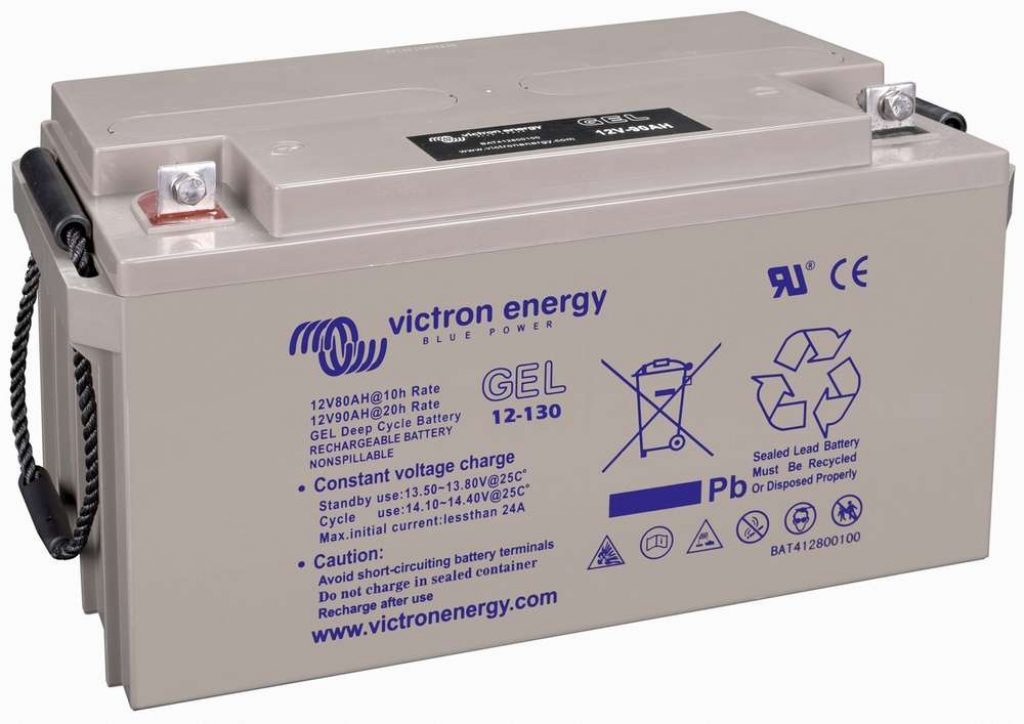
Are Gel Batteries Safe?
They are user-friendly and therefore safe to operate.
Furthermore, they are sealed batteries with no liquid electrolyte.
Finally, gel batteries are leakproof and will not emit toxic fumes while charging.
How Long Do Gel Batteries Last?
Gel batteries have a similar lifespan to AGM batteries. Their total life cycle is greatly influenced by the depth of discharge.
Manufacturers always recommend a 50% DOD to reach 700 cycles of service max.
Are Gel Batteries A Good Choice As Solar Batteries?
Looking for a low-budget technology but one that is still efficient? Gel batteries are a good choice. However, be aware that they will perform well for 2 years, then drop greatly in performance thereafter.
The Lithium Battery
Lithium-ion batteries are rechargeable. They were developed in the ’80s and made available in the early ’90s. Therefore, this green technology is still quite new and benefits from constant improvement.
The average energy density of a commercial lithium-ion battery is 120 Wh/kg.
Here is an overview of a lithium battery’s primary components:
| Component | Material |
|---|---|
| Anode (-) | Carbon |
| Cathode (+) | Metal oxide |
| Electrolyte | Lithium salt |
| Membrane | Porous to Lithium-Ion |
Currently, there are 6 types of lithium-ion batteries. However, we will focus on the Lithium Iron Phosphate battery (LFP) — this is the most widely available on the market.
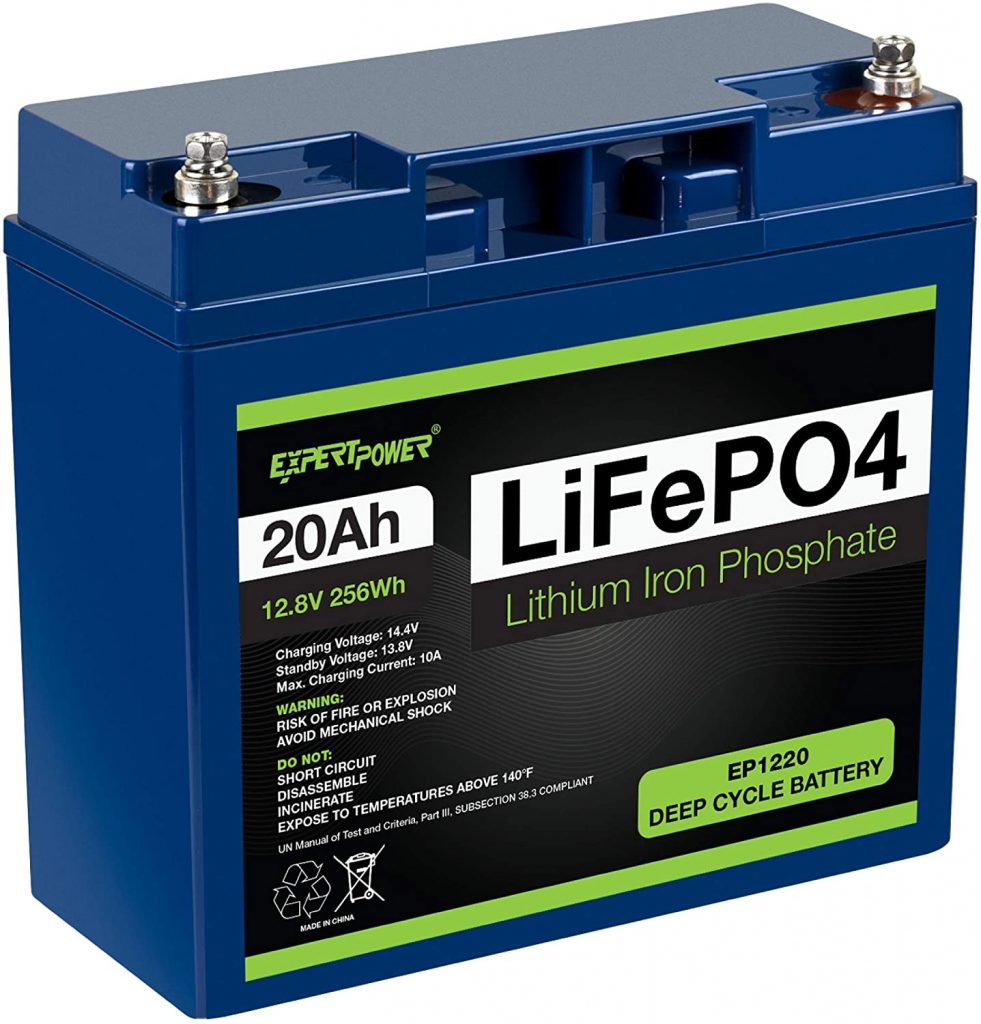
Lithium Iron Phosphate batteries are rechargeable lithium-ion types. Unlike lead-acid batteries, which are one unique system, lithium batteries are composed of an assembly of smaller-sized cells of cylindrical shape.
The industrial standard is the 18650 lithium cell.
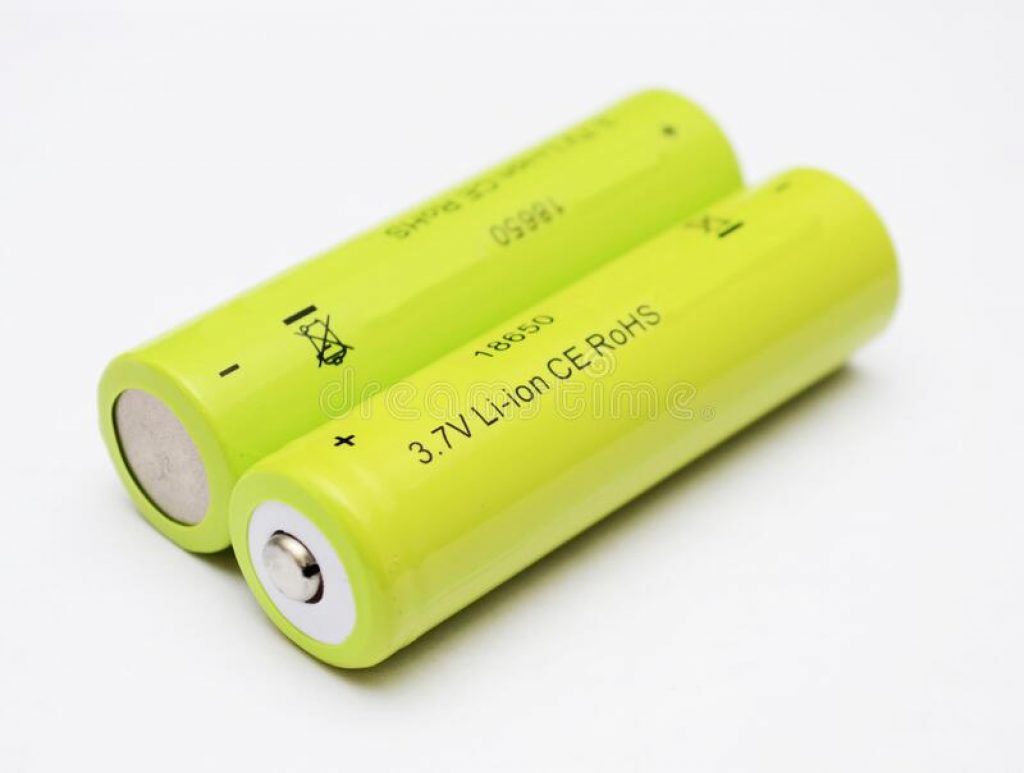
The number of cells can be adjusted to reach the required voltage and energy capacity of the battery pack.
Are Lithium Iron Phosphate Batteries Safe?
Thanks to multiple safety components, Lithium Iron Phosphate batteries are safe to use.
In its pure form, lithium metal is highly flammable when in contact with air or water. Therefore, lithium batteries come with multiple safety components. Each battery cell is carefully sealed in an air-tight cylindrical format.
The cell assembly that composes the lithium-ion battery pack is monitored by a Battery Management System (BMS). The BMS ensures a balanced state of charge in every battery cell at all times. It also prevents overcharging and discharging.
How Long Do Lithium Iron Phosphate Batteries Last?
LFP batteries have a rated lifetime of 2,000 to 4,500 cycles (or 10 years) at 80% depth of discharge.
Why Are Lithium Iron Phosphate Batteries So Expensive?
This type of battery is more expensive than deep-cycle lead-acid batteries because their technology is more recent.
The lithium battery is only 20 years old, compared to 150 years old for lead-acid batteries.
However, their market share is growing rapidly thanks to electric vehicles. Consequently, their price is dropping year after year.
Related Reading: Lithium Battery Cycle Life
Is There A Better Solar Battery Than Lithium?
Lithium batteries like the LFP are currently the best solar batteries available on the market.
The following advantages are associated with LFP batteries:
- Lightweight
- High storage capacity
- Tolerant to rapid and intermittent charging
- Can supply high current load
- Low self-discharging rates
- Full discharge is possible
However, they still have the highest initial cost, but in the end, they demonstrate robustness and reliability in the context of variable solar charging.
Furthermore, you’ll find them cheaper to use in the long term compared to lead-acid types.
How Much Do Solar Batteries Cost?
The cost of a battery varies depending on its capacity and technology.
Therefore, we should provide you with an estimate per usable kWh: In the process, we are taking their usable capacity into account.
For lead-acid batteries, manufacturers recommend discharging them at 50% of their maximum capacity, and for lithium batteries, 80%.
A lithium battery is 2.5 times more expensive than a deep-cycle lead-acid battery for the same available energy. The good news is that the lifetime of a lithium battery is 3 times that of a deep cycle.
In the end, over its lifetime (2000 cycles), your lithium battery will cost less than a deep cycle battery.
| Cost per usable capacity | Overall lifetime cost (2000 cycles) | |
|---|---|---|
| Lithium Iron Phosphate battery (80% DOD) | 565 USD/kWh | 565 USD/kWh |
| Deep cycle battery (Gel, AGM) (50% DOD) | 367 USD/kWh | 1065 USD/kWh |
What Kind Of Battery Is Best For A Solar System?
Lithium iron phosphate batteries are better suited for solar charging than deep cycle lead-acid batteries (Flooded/Wet type, AGM, Gel).
The main reason is that lead-acid batteries require a much longer charging time, up to 16 hours. Most of the time, this is not achievable with solar energy.
For example, numerous tropical countries have only 12 hours of sun per day — this is where lithium iron phosphate batteries are at their best!
In terms of pricing, you’ll find lithium batteries more expensive, at least initially. But over, they will become more cost-effective as time goes on — at least 20% cheaper than lead-acid types.
Our comparative chart below that summarizes the main features of each technology:
| Lithium Iron Phosphate | Wet type | AGM | Gel | |
|---|---|---|---|---|
| Energy density (Wh/Kg) | 120 Wh/Kg | 45 Wh/Kg | 35 Wh/Kg | 35 Wh/Kg |
| Average life cycle 80% DOD | 2000-4000 | 250-350 | 200-300 | 200-300 |
| Cost per usable kWh | 648 USD | 500 USD | 555 USD | 555 USD |
| Self-discharging | 5% | 10% | 5% | 5% |
| Rapid charging | 2 h | 8-16h | 8-16h | 8-16h |
Please note: if your battery has reached its rated life cycle, you can still use it, but its capacity will decline further down to zero. Additionally, it will take more time for a lithium battery to reach zero capacity compared to lead-acid batteries.
Is It Worth Getting Solar Batteries?
Our sun is a natural energy source; therefore, it is variable — its production output varies during the day and in the case of climatic events.
The peak production of the sun is at noon; however, our peak electricity consumption occurs in the morning, around 7 am and 8 pm.
Our consumption is therefore disconnected from the production time. You now see the necessity to store solar energy to exploit the potential of your system.
If you travel in a camper van equipped with solar panels, you will undoubtedly need electricity for the light in the evening. Consequently, you will store the electricity produced by your monocrystalline solar panel during the day to release it at night.
How Much Is A Solar Battery For A House?
A 2 kWh battery with a 2kW power peak for domestic use costs around $1,500. Above all, it comes with a 10-year warranty (or 4,500 cycles) at 70% of the rated capacity.
This storage capacity will be enough to run the whole domestic appliance for 1 day. You can associate multiple batteries to increase the overall capacity of your system.
You will need to purchase an inverter to convert DC current into AC used by your appliance.
Over the last ten years, the cost of lithium batteries for domestic use dropped dramatically, meaning that the technology is now accessible to all and is replacing the fuel generator in off-grid systems.
Can You Use Car Batteries For Solar Power?
If you’re on a limited budget, you can use your car battery as a solar battery. Even second-hand car batteries will still operate under a low power load (lights).
Car batteries are 12V lead-acid batteries that can supply high currents for a limited time.
Coupling solar panels and car batteries will work. However, your system will not be optimized as car batteries are not designed for deep discharge or intermittent charging. In addition, the life duration of your battery will be low.
How Much Money Can You Make With A Solar Battery?
In 2022, you can combine net metering and electricity surplus compensation to make money off your solar battery.
With the global energy price surge, you can save and earn thousands of dollars with your solar battery coupled with solar panels.
Example
Let’s see how with a system installed in Los Angeles, California.
Electricity bills are always paid regarding the number of kWh used in a month. In Los Angeles, as of April 2022, you will pay, on average, $0.3/kWh (depending on the rate plan).
So, if your system couples a solar battery with a solar panel and has a lower cost per kWh, you earn!
Levelized Cost Of Energy
First, calculate your system’s LCOE (Levelized Cost Of Energy). LCOE is expressed in USD/kWh and considers your system’s global production during its lifetime: 25 years for the solar panels and 10 years for the batteries and electrical systems.
For a 5kW solar panel, the LCOE is $0.04/kWh (average price inc. installation and tax rebates in California)
LCOE Solar battery (Alpha ESS Smile 5): $0.16/kWh
Total estimate LCOE: $0.2/kWh
Ultimately, your solar battery system will cost less than $0.3/kWh; therefore, it is already competitive with utility prices in California.
Net Metering & Net Surplus Compensation Program
Follow the two steps below to reduce your electricity bill and earn with a solar battery:
Step One:
Opt for net metering. With this scheme, every kWh that you supply to the utility company is credited to your account. You can then use utility electricity for free until your account is back to zero.
You don’t earn money with net-metering rather you save money (a lot!).
Step Two:
To earn money, opt for the Net Surplus Compensation program. PGE (Pacific Gas and Electricity Company) can pay your surplus at $0.047/kWh (rate of May 2022).
For example, if your net metering account ptis already credited with worth 3-4 days of your domestic consumption, you can opt to sell the rest of your electricity. Therefore, your solar battery becomes profitable.
Can You Build Your Own Solar Battery ( DIY)?
With the advent of Lithium batteries, even a non-specialist can build their own solar battery:
A Solar lithium battery is made of the following components:
- Lithium cell modules
- Battery Management System (BMS)
- Battery balancer
- Wires and connectors
You can purchase all these parts online individually. The advantages include:
- Cheaper than a ready-made solar battery
- Can customize each part
- Select better quality components
As an example, a DIY solar battery with a 3kWh capacity will cost you:
$484 for the battery cell + $134 BMS + $35 balancer + $35 electrical connectors:
Total = $690
For the same capacity, that’s around 30% cheaper than buying a ready-made low-cost lithium battery from Amazon.
Five Of The Best Solar Batteries On The Market
When looking for a solar battery you want to focus on 4 main parameters:
- Usable battery capacity or depth of discharge
- Durability (the number of cycles)
- Adaptability to solar energy charging
- Price
We’ve selected the 5 best solar batteries on the market:
Best Solar Battery For Heavy Domestic Use

- Huge 13.5 kWh storage capacity
- Plug-and-play design with a built-in inverter to deliver Alternative Current (AC)
- Enough energy for 3 days of total autonomy
- Longest warranty: 10 years at 70% initial capacity
- Lowest cost per kWh over its lifetime
Best GEL Battery For On-Board And Domestic Use
Renogy Gel battery Deep Cycle (12 V, 100 Ah)

- 0.6 kWh of usable capacity
- Maintenance free
- Can supply high discharge current
- Has the lowest self-discharging rate (3% per month)
- Can operate at temperatures below zero degrees
Best AGM Battery For On-Board And Domestic Use
Renogy AGM battery Deep Cycle (12 V, 100 Ah)

- 0.6 kWh of usable capacity
- Maintenance free
- Extended life duration: 750 cycles at 50% DOD
- Lowest self-discharging rate (3% months)
- Safe to operate
Best Lithium Iron Phosphate Battery For Domestic Use
Renogy Smart Lithium Iron Phosphate Battery (48V, 50Ah)
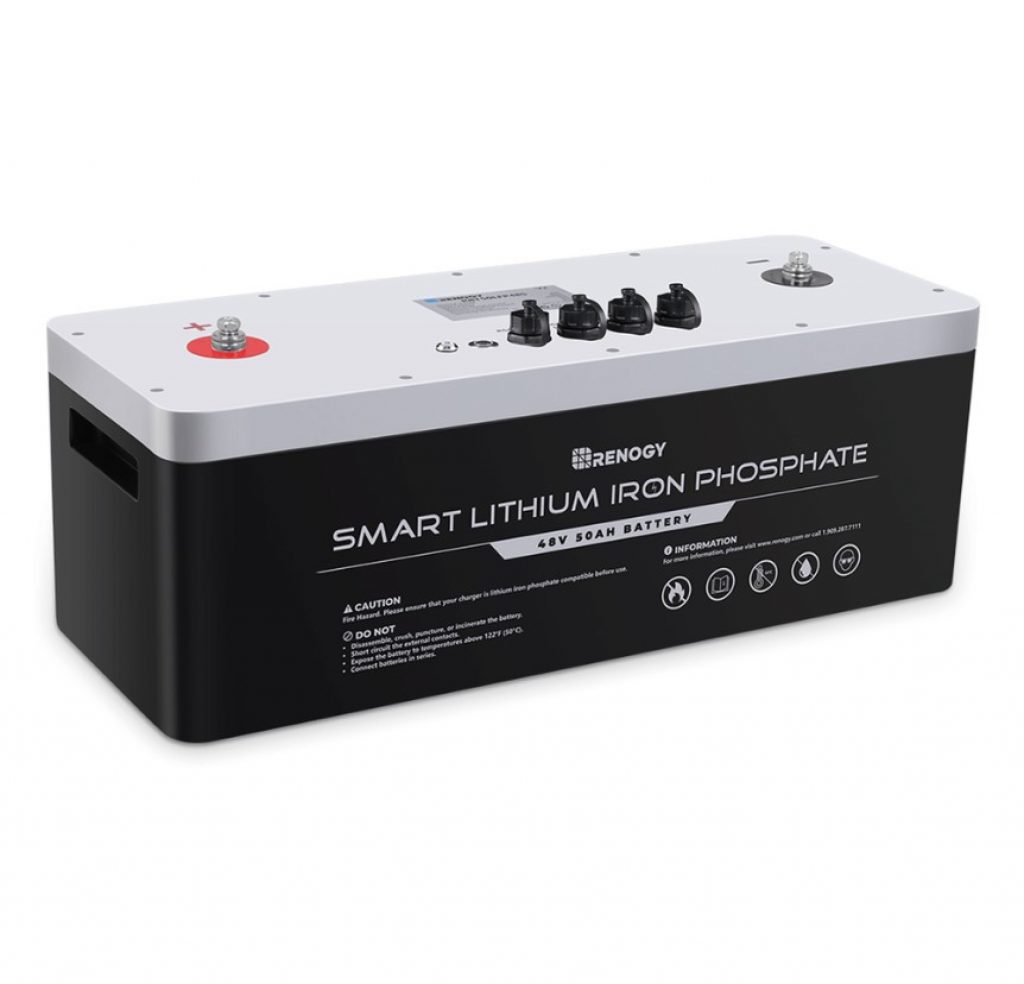
- 2 kWh of usable energy
- Extreme life duration: 4’500 cycles or 10 years
- Support fast charging/discharging up to 50A
- High tolerance to intermittent solar charging
- Associate multiple batteries to increase the capacity of your system
Best Lithium Iron Phosphate Battery For On-Board Use
Renogy Lithium Iron Phosphate Battery, 12 V, 50 Ah

- 0.8 kWh of usable energy
- Long life duration: 2’000 cycles
- Support fast charging/discharging up to 50 A
- High tolerance to intermittent solar charging
- Associate multiple batteries to increase the capacity of your system
- Lightweight for in-board use
Final Thoughts
There is a solar battery for every need and every budget.
AGM and Gel lead-acid batteries are well adapted to low-budget and small-capacity systems.
Conversely, lithium-iron phosphate batteries are the best when it comes to storing solar energy. They are perfect for domestic and in-board use (boat, RV, etc.).

